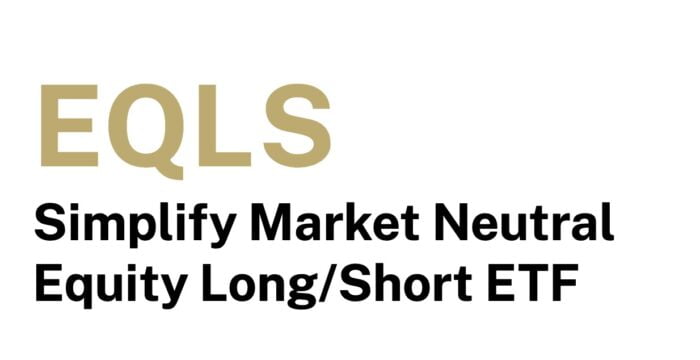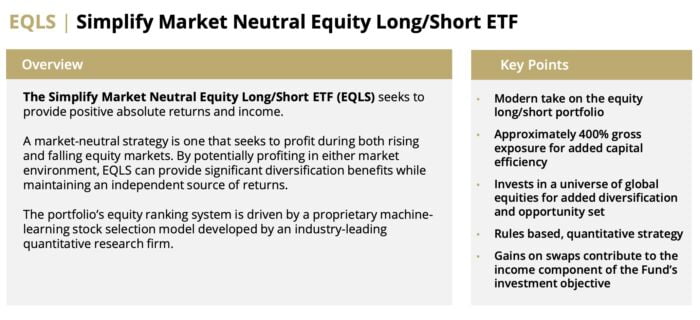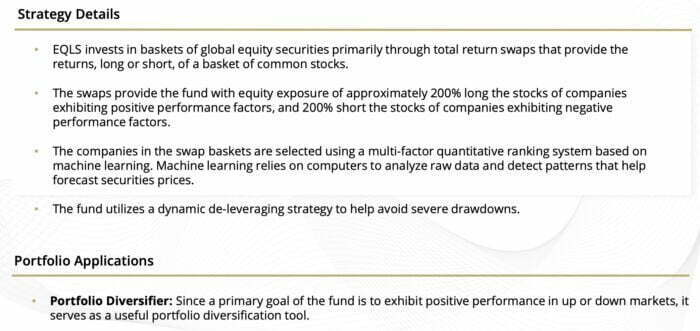I often yawn or roll my eyes when new ETFs are released.
They tend to be boring, vanilla or copycat strategies in what is already a saturated marketplace.
EQLS ETF is the rare exception.

It’s a high conviction alternative market-neutral equity strategy that seeks absolute returns during any market condition.
It’s got some oomph behind it with a gross 400% exposure.
Moreover, it’s a strategy that can potentially diversify your portfolio featuring a classic long-only asset allocation to stocks and bonds.
Without further ado, let’s find out more about EQLS ETF!

Reviewing The Strategy Behind EQLS ETF (Simplify Market Neutral Equity Long/Short)
source: Simplify Asset Management on YouTube
Hey guys! Here is the part where I mention I’m a travel content creator! This “The Strategy Behind The Fund” interview is entirely for entertainment purposes only. There could be considerable errors in the data I gathered. This is not financial advice. Do your own due diligence and research. Consult with a financial advisor.

These asset allocation ideas and model portfolios presented herein are purely for entertainment purposes only. This is NOT investment advice. These models are hypothetical and are intended to provide general information about potential ways to organize a portfolio based on theoretical scenarios and assumptions. They do not take into account the investment objectives, financial situation/goals, risk tolerance and/or specific needs of any particular individual.

What’s The Strategy Of EQLS ETF?
For those who aren’t necessarily familiar with a “market neutral” style of investing, let’s first define what it is and then explain this strategy in practice by giving some clear examples.
EQLS is designed to be a market (or beta) neutral, notional neutral, and regional neutral global equity strategy, seeking positive returns at a lower volatility independent of market direction.
The goal is to offer true portfolio diversification by seeking return streams derived from stock picking alpha that are uncorrelated to broad asset classes (equities, bonds), as well as traditional quant strategies, with the potential to perform in up or down markets.
As a specific example of market neutral equity exposure, let’s say the fund bought shares of Canadian National Railway Co. (ticker CNR CN), and shorted shares of Canadian Pacific Kansas City Limited (CP CN). The reason for this could be that CNR was considered a better quality company when looking at profitability (CNR’s ROE was in the 87th percentile while CP was in the 40th percentile), and had better analyst sentiment, such as more upward EPS revisions over the past 3 months, indicating increasing optimism about the company’s future. The fund would then have both positive and negative exposure to Canadian rail transport companies, at the same time. Regardless of whether Canadian industrial stocks rise or fall as a whole, the long exposure to Canadian National Railway and short exposure to Canadian Pacific Kansas City balance each other out, and the hope is that the higher ranked stock outperforms the lower ranked stock.


Unique Features Of Simplify Market Neutral Equity Long/Short Fund EQLS ETF
Let’s go over all the unique features your fund offers so investors can better understand it.
What key exposure does it offer?
Is it static or dynamic in nature?
Is it active or passive?
Is it leveraged or not?
Is it a rules-based strategy or does it involve some discretionary inputs?
How about its fee structure?
EQLS’s key exposure is 200% long, 200% short global equities resulting in 400% gross equity exposure and 0% net equity exposure. So yes, it is leveraged. This actively managed strategy is rules-based, using a quantitative model with approximately 500 data inputs. The strategy offers exposure to traditional quant factors such as value, growth, quality, price momentum/reversal, and analyst sentiment factors. Non-traditional alternative (technicals, risk, liquidity, size) as well as big data (news-based) factors are also used. The strategy is dynamic in nature as the model is re-trained frequently based on the latest factor behaviors.
Portfolio construction begins with a starting universe of the MSCI World Index. Hard to borrow (expensive to short) names are removed. The algorithm’s 300 highest ranked stocks are longs and the 300 lowest ranked stocks are shorts. Four underlying models are used to generate the rankings: short term (prior month data), medium term (trailing 12 months of data), seasonal (trailing 10 years of data) and hedge (designed to perform when other models are performing poorly.)
The positions are re-ranked based on forward one-month predicted returns and rebalanced monthly. Maximum gross exposure to a single stock is 2%. Lastly, a dynamic risk-reduction model is in place to lower exposure during drawdowns. The fund has a 1.00% expense ratio.
We also expect the fund to have a large potential capacity in terms of AUM – performance of the strategy should be relatively consistent as the AUM of the ETF grows, even to the multi-billion level.

What Sets EQLS ETF Apart From Other Alternative Funds?
How does your fund set itself apart from other “market neutral and long-short” alternative funds being offered in what is already a crowded marketplace?
What makes it unique?
Most liquid (mutual fund or ETF) products in this space are not truly market neutral and are in fact net long. Any products in this space are designed for very low volatility – with accompanying low returns.
The strategy uses state of the art machine learning algorithms and portfolio construction techniques, focusing on idiosyncratic (or stock picking) alpha rather than traditional risk premia. The strategy is uncorrelated not only to the equity market, but also to other traditional quant strategies. In addition, the 4x leverage at less than 10% targeted annualized risk offers investors the potential opportunity for appealing returns with limited risk.
What Else Was Considered For EQLS ETF?
What’s something that you carefully considered adding to your fund that ultimately didn’t make it past the chopping board?
What made you decide not to include it?
We considered varying levels of leverage, ultimately settling on what we believe was a sweet spot of return/volatility. We also considered not controlling for some of the style factors, such as momentum, but hypothetical modeling resulted in larger drawdowns during momentum selloffs.

When Will EQLS ETF Perform At Its Best/Worst?
Let’s explore when your fund/strategy has performed at its best and worst historically or theoretically in backtests.
What types of market conditions or other scenarios are most favourable for this particular strategy?
On the other hand, when can investors expect this strategy to potentially struggle?
On an absolute return basis, there is no real market environment which favors the strategy. Hypothetical modeling that informed the creation of the strategy have been consistent across different market environments. For compliance purposes, please note that there is no backtest for the fund itself. On a relative return basis versus long-only equities, we expect the best returns during stock market drawdowns.
Further, we expect the strategy to perform best when quant factors behave as expected (e.g. companies with high ROE’s should perform better than less profitable companies). We expect the strategy to underperform when factors behave contrary to their historical performance. For example, if a factor is crowded and heavily-shorted stocks rally, causing a short squeeze, this can hurt performance in the short term.
The strategy typically has positive exposure to profitability (ROE), momentum, analyst EPS revisions, and earnings yield factors, and negative exposure to volatility and short interest utilization factors, to name a few. We expect the strategy to perform better during risk-off periods because of these factor exposures, which historically exhibit long-term positive returns. Again, the strategy is dynamic – the model is re-trained monthly based on latest factor behaviors, at which point the stocks within the long and short baskets are rebalanced.

Why Should Investors Consider Simplify Market Neutral Equity Long/Short Fund EQLS ETF?
If we’re assuming that an industry standard portfolio for most investors is one aligned towards low cost beta exposure to global equities and bonds, why should investors consider your fund/strategy?
The holy grail of diversification is achieved by adding a low-correlation asset that has an independent source of returns. The HFRI EH: Market Neutral Index has a near-zero correlation with the MSCI World Index as well as with the Bloomberg Aggregate Bond Index. There are times when the two-legged stool of stocks+bonds tips over (e.g. 2022). That’s exactly when the benefits of adding an additional asset with low correlations becomes most apparent.

How Does EQLS ETF Fit Into A Portfolio At Large?
Let’s examine how your fund/strategy integrates into a portfolio at large.
Is it meant to be a total portfolio solution, core holding or satellite diversifier?
What are some best case usage scenarios ranging from high to low conviction allocations?
EQLS is a satellite/diversifier. A reasonable allocation would be somewhere around 5% to 20% of a portfolio. An investment in EQLS can be sourced pro-rata from an existing stock/bond portfolio. For example, if an investor starts with a 60/40 portfolio and decides to allocate 10% to EQLS, the remaining portfolio would be allocated in the original 60/40 proportions, resulting in: 54% stocks, 36% bonds, and 10% EQLS. This strategy can also be used by hedge fund allocators to replace high-cost quant hedge funds, considering the 2/20 fees those typically charge.

The Cons of EQLS ETF
What’s the biggest point of constructive criticism you’ve received about your fund since it has launched?
The fund has just launched (June of 2023) so our track record is limited. However, we have seen a significant amount of investor demand and the fund has already surpassed $100M in AUM, so investors are placing faith in the exposure and process to potentially deliver future results.

The Pros of EQLS ETF
On the other hand, what have others praised about your fund?
Most investors we’ve spoken with appreciate the fact that the fund, with 400% gross exposure, is really trying to move the needle. Many products in the space are watered down, with extremely low volatility and returns.
Without leverage, the average return of the ETF may be less appealing to investors, particularly in the current high-interest-rate environment where alternative fixed income products are available. By incorporating leverage, the ETF aims to offer more attractive returns.
Learn More About EQLS ETF
We’ll finish things off with an open-ended question.
Is there anything that we haven’t covered yet that you’d like to mention about your fund/strategy?
Investors can read more about EQLS here:
https://www.simplify.us/etfs/eqls-simplify-market-neutral-equity-long-short-etf
source: Simplify Asset Management on YouTube
Connect With Simplify ETFs
Twitter: @SimplifyAsstMgt
YouTube: Simplify Asset Management
Simplify Asset Management: Simplify ETFs
Fund Page: EQLS ETF

Nomadic Samuel Final Thoughts
I want to personally thank Dave Jackson for taking the time to participate in the “The Strategy Behind The Fund” series by contributing thoughtful answers to all of the questions!
If you’ve read this article and would like to have your fund featured, feel free to reach out to nomadicsamuel at gmail dot com.
That’s all I’ve got!
Ciao for now!
Important Information
Investment Disclaimer: The content provided here is for informational purposes only and does not constitute financial, investment, tax or professional advice. Investments carry risks and are not guaranteed; errors in data may occur. Past performance, including backtest results, does not guarantee future outcomes. Please note that indexes are benchmarks and not directly investable. All examples are purely hypothetical. Do your own due diligence. You should conduct your own research and consult a professional advisor before making investment decisions.
“Picture Perfect Portfolios” does not endorse or guarantee the accuracy of the information in this post and is not responsible for any financial losses or damages incurred from relying on this information. Investing involves the risk of loss and is not suitable for all investors. When it comes to capital efficiency, using leverage (or leveraged products) in investing amplifies both potential gains and losses, making it possible to lose more than your initial investment. It involves higher risk and costs, including possible margin calls and interest expenses, which can adversely affect your financial condition. The views and opinions expressed in this post are solely those of the author and do not necessarily reflect the official policy or position of anyone else. You can read my complete disclaimer here.






